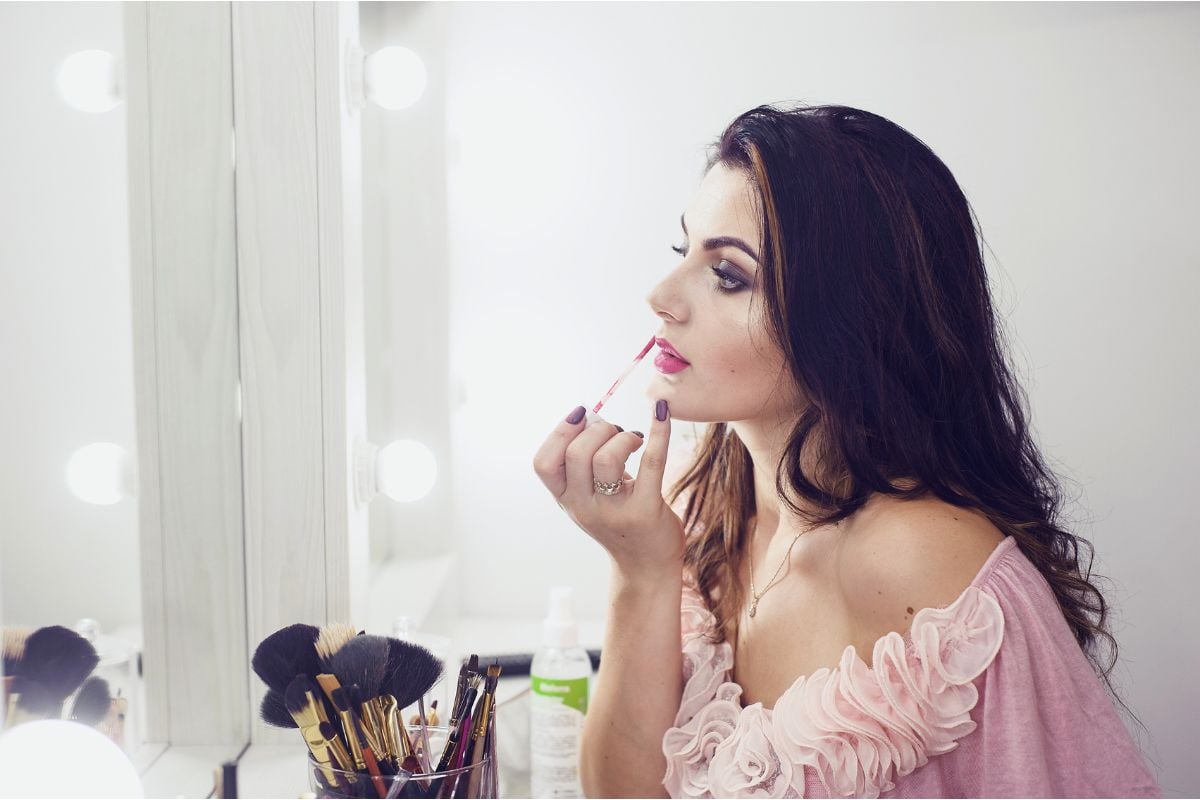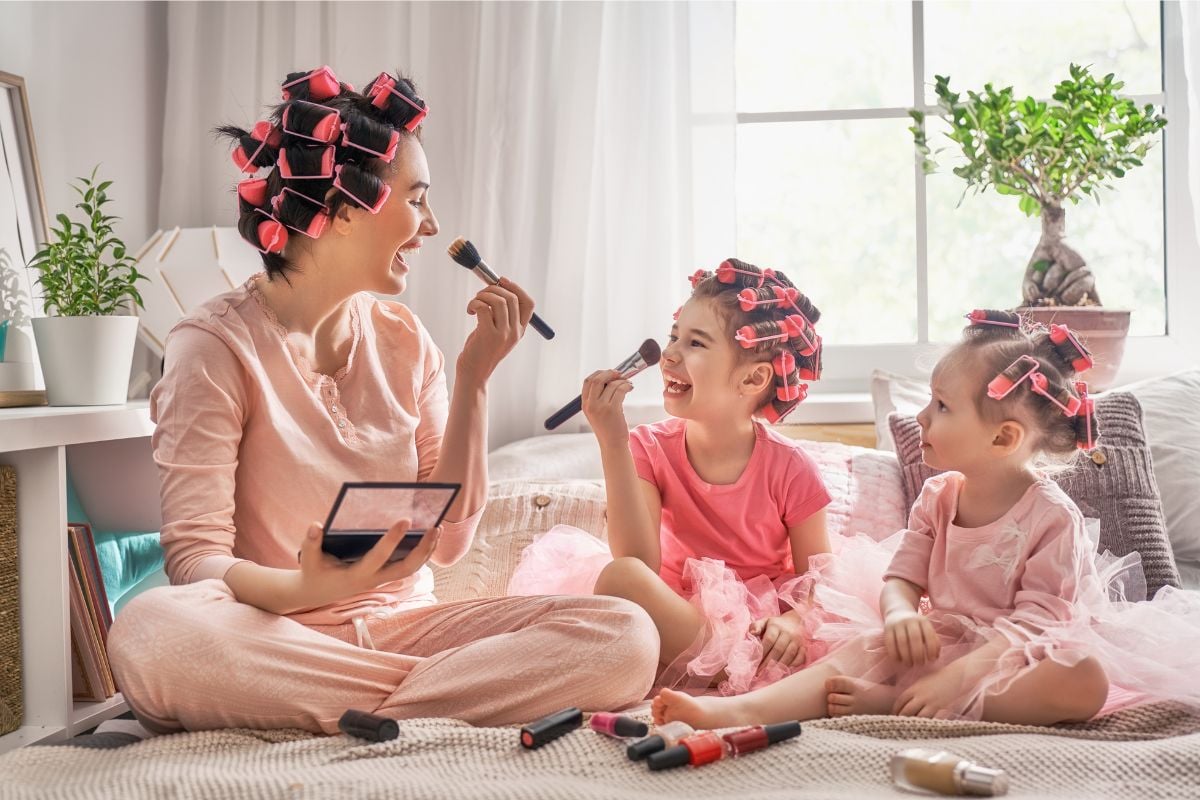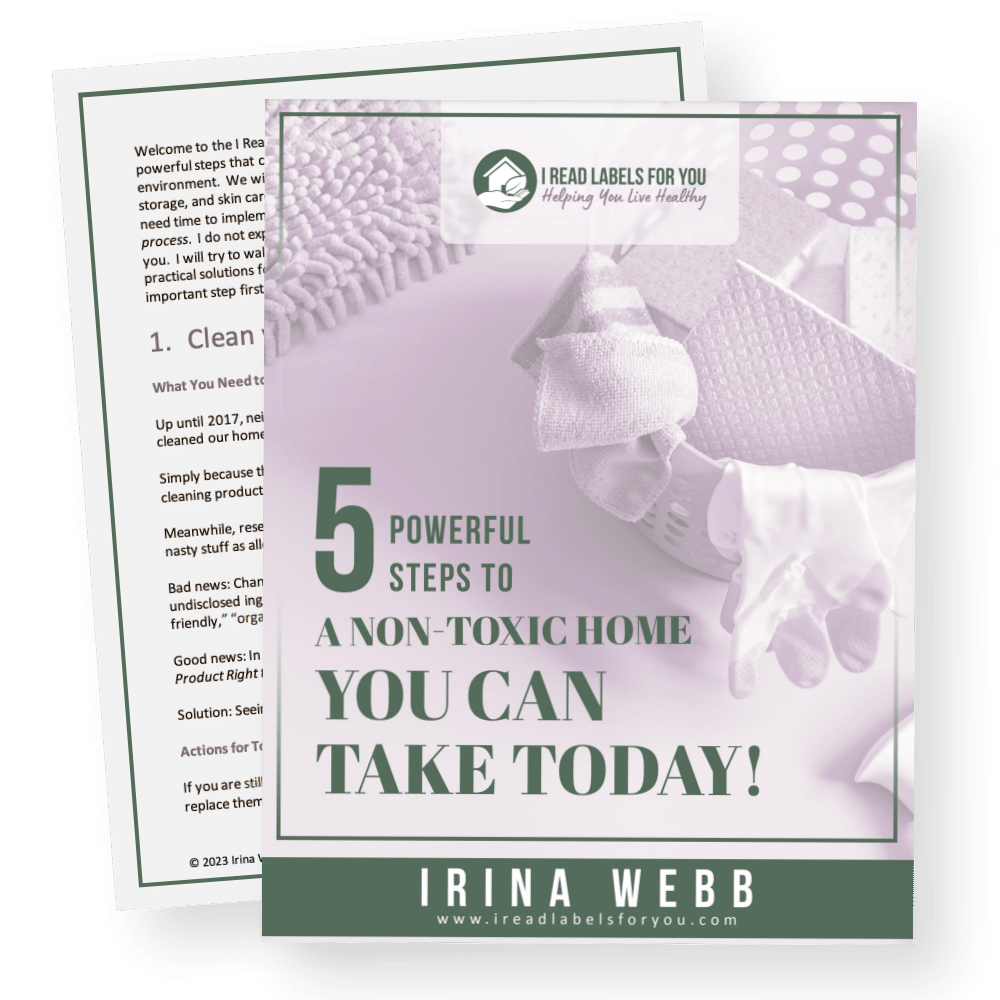12 Potentially Toxic Chemicals in Makeup List

Makeup, though a seemingly simple set of products with a straightforward purpose, includes a long list of ingredients. Some of the ingredients are potentially toxic chemicals, and applying them to your skin can put you at risk of a variety of ailments, including allergic reactions, cancer, immunotoxicity, and endocrine disruption. The longer and more frequently you use products with these ingredients, the more they could be potentially hazardous to your body.
Avoiding these chemicals is in the best interest of not only your health, but also the health of the environment. Many added toxic ingredients are persistent and contaminate our planet as well. This post will reveal these potentially toxic chemicals and provide safe makeup and personal care alternatives. Here are the potentially toxic ingredients to remove from your vanity.
12 Potentially Toxic Chemicals
Talc
Talc is used to absorb moisture and is added to powders like blush, eye shadow, baby powder, and more. Despite its widespread use, The International Agency for Research on Cancer (IARC) has linked talc-containing asbestos to cancer and considers it carcinogenic to humans. Talc that does not contain asbestos isn’t currently considered carcinogenic, but there have been few human studies to confirm or deny this claim.
The IARC ascertains, based on limited evidence from human studies, that perineal (genital) use of talc through body powder potentially increases the risk of cancer as well. The European Commission demands companies using talc for children under the age of three add the label: “Keep powder away from children’s nose and mouth.” The EC also has talc listed on a heavily regulated ingredient list that is meant to discourage the use of the substance.
Synthetic Petroleum-Based Dyes
Synthetic dyes are derived from coal, tar, and petroleum. These ingredients contain residues of heavy metals, including lead, and have been associated with carcinogenicity, genotoxicity, and hypersensitivity (source). Here are some ways petroleum-based dyes may appear on makeup labels:
- Red 36 Lake
- Yellow 5 Lake (CI 19140) or CI 19140
- Red 7 Lake (CI 15850) or CI 15850
- Red 27 Lake (CI 45410) or CI 45410
- Blue 1 Lake (CI 42090) or CI 42090)

Fragrance
Fragrances, often listed on ingredient lists as “parfum,” are a hidden mix of ingredients added to cosmetic products to produce a scent. As mentioned, the ingredients do not have to be disclosed; therefore, many companies don’t disclose them, claiming that they are “proprietary.” Despite the ingredients being unknown, the International Fragrance Association (IFRA) released a list of 3,619 materials it considers “safe” for use in cosmetic fragrances (source).
However, many fragrance ingredients are truly not safe. In fact, many are listed as main allergens by the European Committee on Consumer Safety and are associated with allergic contact dermatitis and respiratory distress. Substances supposedly allowed for fragrance solutions include ingredients like styrene, diethyl phthalate, and butylphenyl methylpropional. These substances have been associated with reproductive toxicity, endocrine disruption, and cancer. Butylphenyl methylpropional was even banned from use in the European cosmetic industry due to fertility and prenatal concerns (source). Even so-called natural fragrances out there may contain these ingredients.
Triethanolamine
In cosmetics, triethanolamine (TEA) is used as a surfactant or a pH adjuster. The European Chemicals Agency (ECHA) suspects that triethanolamine may have negative effects on fertility and pregnancy (source). Additionally, the U.S. Cosmetic Ingredient Review (CIR) expert panel recognized the presence of N-nitrosating agents in many products with TEA, leading to the potential propagation of possibly carcinogenic nitrosamine N-nitrosodiethanolamine. Hence, TEA should not be used with N-nitrosating agents in formulations (source).
The European Commission corroborates this conclusion by administering the following restrictions (source):
- TEA cannot be used with nitrosating agents.
- TEA must have a 99% purity with a maximum secondary amine content of 0.5% and a nitrosamine content of 50 micrograms or less.
- The TEA-containing product must be in nitrite-free containers.
TEA can still be used in leave-on products in Europe as long as the concentration is at or below 2.5%. The United States does not regulate triethanolamine.
Cyclopentasiloxane
The cyclopentasiloxane (D5) gives skincare and haircare products a silky and slippery feel as you apply them. The European Chemicals Agency (ECHA) reports that cyclopentasiloxane is an environmental contaminant and is persistent, bioaccumulative, and toxic. (Bioaccumulative means the toxin builds up in the body of humans and animals over time.)
Furthermore, in animal studies, high doses of cyclopentasiloxane contributed to an increased risk of cancer. It may also contain the residue of cyclotetrasiloxane that the European Commission banned from use in cosmetic products. Yet, it is legal to use it in the US. For more on this topic, visit the Intriguing Story of Cyclopentasiloxane blog post.

Alumina, Aluminum Hydroxide, and Other Aluminum Ingredients
Elemental aluminum is controversial. It has been linked to Alzheimer’s, and studies have concluded it may contribute to the body’s depletion of phosphorus, calcium, magnesium, and iron. However, the US Cosmetic Ingredient Review expert panel claims systemic exposure to aluminum ingredients in cosmetics is negligible because it is absorbed poorly by the body (source).
Other research notes that aluminum is bioaccumulative and potentially a pro-oxidant, which could significantly increase the potential for oxidative damage to the skin (source). There are currently no regulations on the use of aluminum ingredients.
Titanium Dioxide in Loose Powders and Aerosol Sprays
Titanium dioxide is a very common pigment that gives cosmetics opacity and sunscreens a UV filter. The dust of airborne titanium dioxide nanoparticles has been linked to lung cancer by the International Agency for Research on Cancer and by the California Office of Environmental Health Hazard Assessment.
The State of California recommends careful and minimal use of titanium dioxide to decrease its environmental impact. Furthermore, the European Scientific Committee on Consumer Safety has issued recommended safe concentrations of titanium dioxide that are as follows:
- 1.4% in aerosol sprays for general consumers
- 1.1% in aerosol sprays for hairdressers
- 25% in loose powder face make-up
Ethoxylated Ingredients
To start with, ethoxylated ingredients belong to the top six groups of hidden ingredients in cosmetics. They are used as surfactants and help reduce skin irritation in fragrances, shampoos, body wash, bubble bath, and other beauty items (source). Further, a byproduct of the chemical process ethoxylated ingredients catalyze (a process called ethoxylation), 1,4 dioxane, is potentially carcinogenic.
There is currently no required testing for ethoxylated ingredients. So, although 1,4 dioxane can be safely removed, most cosmetic companies do not bother to test for its presence. Nevertheless, the European Commission Scientific Committee on Consumer Safety (SCCS) considers up to 10 ppm of 1,4 dioxane safe in cosmetic products.
Related: Hidden Ingredients In Body Products

Hydroquinone
Hydroquinone is used in nail polishes, skin care products, hair dye, and lipstick, and is another potentially toxic ingredient in makeup (source). It is often included in skin care products meant to lighten dark spots. This is the main concern with hydroquinone, because concentrations of skin lightening products over 2% can cause severe skin irritation and potentially increase the risk of cancer. It also negatively affects the environment, and Health Canada strongly recommends staying below the 2% concentration (source).
Parabens
Parabens are preservatives used in cosmetics and other products. Studies show they can disrupt the endocrine system and potentially contribute to the formation of breast cancer.
However, in 2005, the European Commission couldn’t corroborate findings that parabens are possible carcinogens. They claim this despite evidence that shows parabens bind to estrogen receptors to activate genes controlled by the receptors, stimulate cell growth, and increase the level of immunoreactive estrogen receptor protein. All of this could lead to the development of breast cancer.
Although in 2015, the European Commission banned benzylparaben, isobutylparaben, isopropylparaben, phenylparaben, and pentylparaben from use in cosmetic products, they are still legal in the US.
Petrolatum
Petrolatum is used as a moisturizing agent in cosmetics and skin care products. It has been potentially linked to cancer, so the European Commission has banned its use in most cosmetic products. The only exception to this rule is if the full refining history of that petrolatum has been proven non-carcinogenic during its total time on the market. As for the US, it has not regulated petrolatum inclusion in cosmetic products.
Polytetrafluoroethylene
Polytetrafluoroethylene (PTFE) is a polymer of tetrafluoroethylene, known under the brand name Teflon. It has a plethora of uses outside of cosmetics, but in the category of personal care items, it is used to make the product more durable and waterproof. In addition, makeup manufacturers use it to “condition” the skin and give it a “dewy” look.
PTFE may contain perfluoroalkyl and polyfluoroalkyl substances (PFAS) that are associated with many health effects. They are potentially carcinogenic and toxic to both the reproductive system and the immune system (source). PFAS are persistent in the environment and accumulate in people and wildlife (source).
Furthermore, in many cases you won’t see PFAS among makeup ingredients as they can show up as makeup contaminants. For example, as I described in my Clean Foundation Guide blog post, in December 2022, Leah Segedie of Mamavation sent a sample of Ilia True Skin Serum Foundation and found 404 ppm of organic fluorine, which is an indication of possible PFAS presence. To learn more about the testing for PFAS, read the Environmental Health News.

Non-Toxic Makeup Brands
Now for the good news. Here are some brands I love, use, and trust!
Crunchi
I consider Crunchi to be the best non-toxic makeup brand. They also have an awesome collection of toxin-free anti-aging skincare products. Besides, they never greenwash or falsely advertise their ingredients and have always been transparent with me when I ask questions. In addition, Crunchi uses independent third parties to test for heavy metals and PFAS and passes the tests with flying colors. I consider all Crunchi products safe. On top of that, I highly appreciate their eco-friendly packaging. Get 10% off on the first purchase of $50+ with my Crunchi link and the discount code ADVOCATE10.
Personally, I use Crunchi makeup regularly as my research has confirmed to me that their cosmetics are safe. While I love most of their toxin-free products, I must admit that I am not a big fan of their mascara (even though many people love it). Yet, after a long search, I haven’t found a clean mascara I trust. Presently, I use Ilia Beauty mascara, but I must warn you that the Ilia Beauty foundation tested positive for organic fluorine, a proxy for PFAS.
Related: Crunchi Non-Toxic Makeup Review
Beautycounter
Beautycounter is a popular makeup brand that is honest with their customers about their included ingredients. Although I don’t recommend all Beautycounter products, I mention them here because they also passed independent PFAS and heavy metals tests.
The Beautycounter products I do not recommend are those that include synthetic colorants and phenoxyethanol. But, they have plenty of products I do recommend like foundation, brow gel, highlighter, and glow cream shadow.
Related: Guide To Clean Foundation
Conclusion About Toxic Chemicals in Makeup
The Twelve Listed Ingredients Should Be Omitted From Any Safe Makeup Routine.
Most of us apply makeup every day. If there are any toxic chemicals in our products, we are exposing ourselves to those potentially harmful ingredients day after day, and the long-term effects could be damaging to our health and the environment. Avoid these 12 toxic chemicals and opt for one of the recommended clean makeup brands. To get more information on ingredients to avoid in your food and products, visit the I Read Labels For You Blog.

Download The Free Guide!
5 Powerful Steps To A Non-Toxic Home
Join our informed consumer community and get our free guide the “5 Powerful Steps To A Non-Toxic Home”.

 Written by
Written by 





Before commenting, please read our Comment Policy.